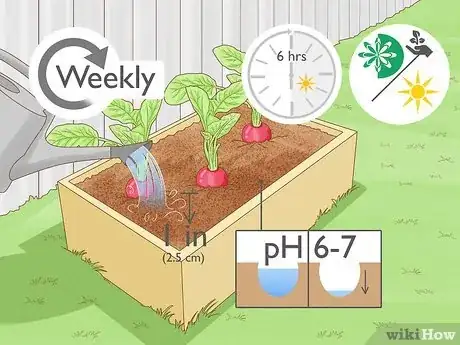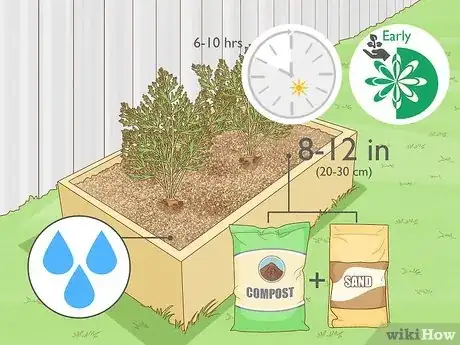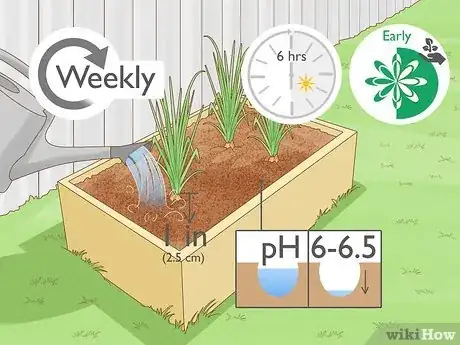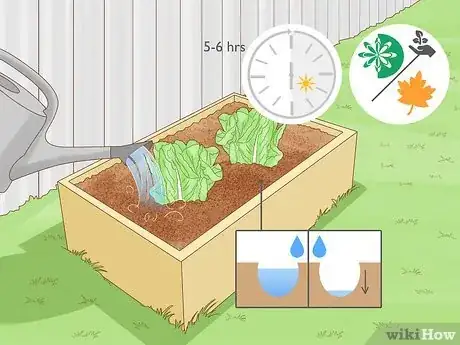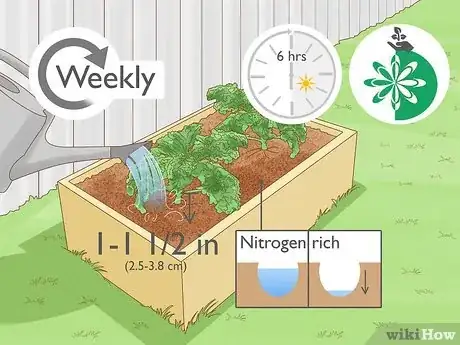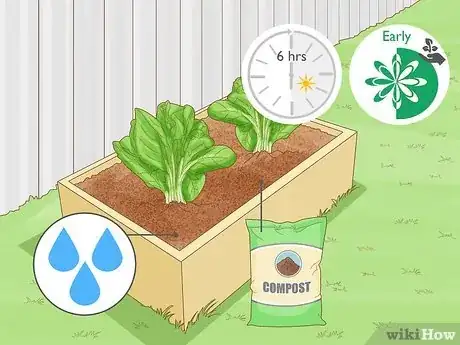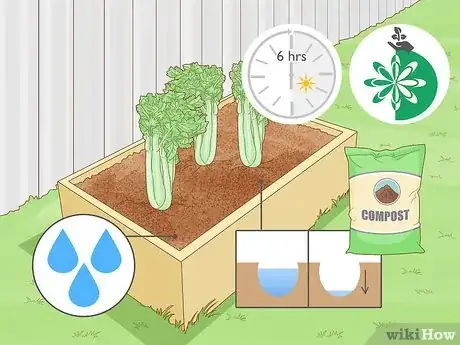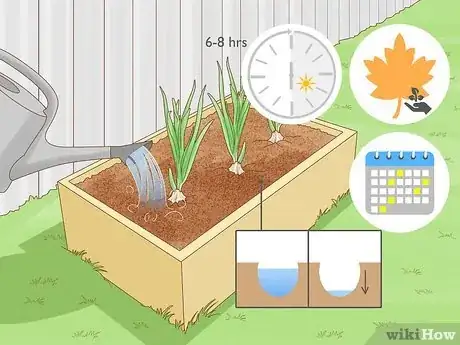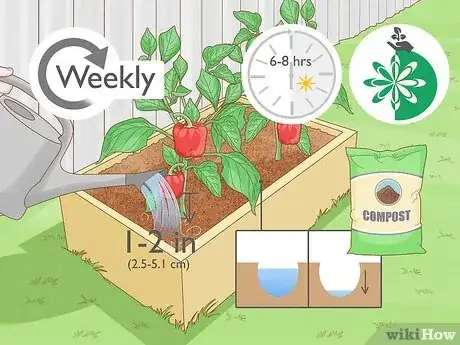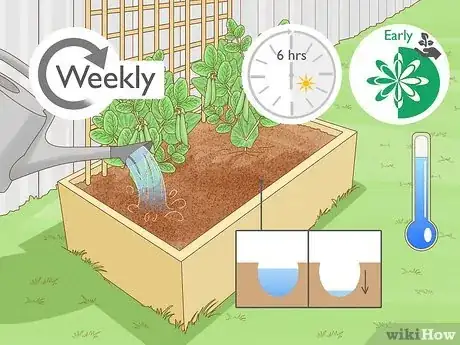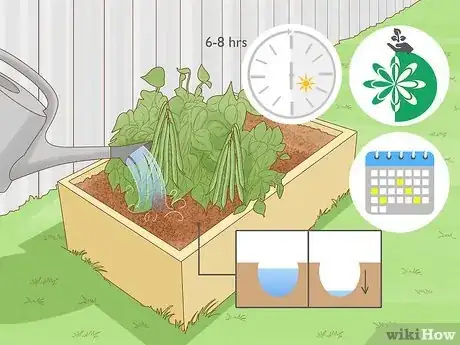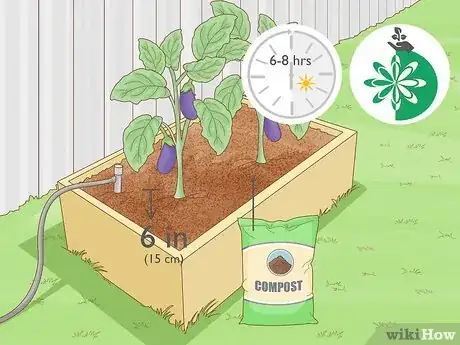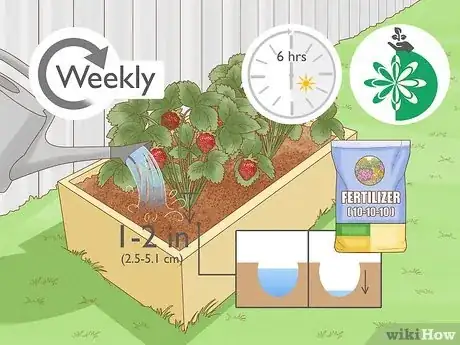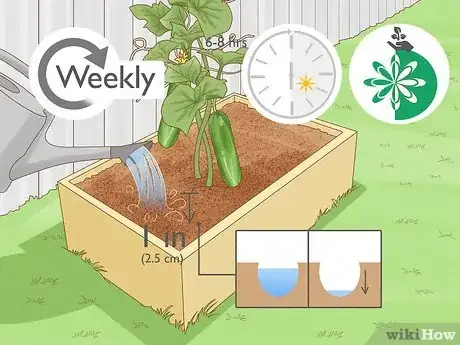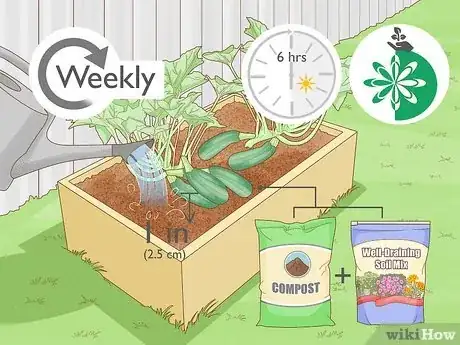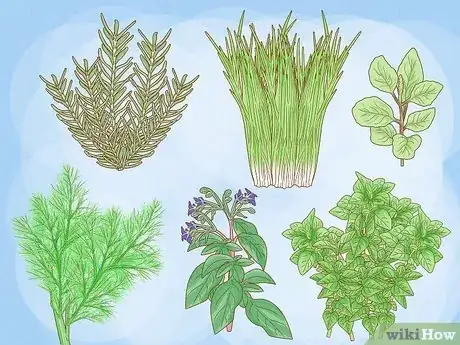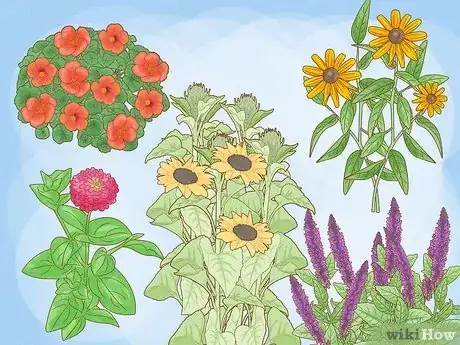This article was written by Ben Barkan and by wikiHow staff writer, Hunter Rising. Ben Barkan is a Garden and Landscape Designer and the Owner and Founder of HomeHarvest LLC, an edible landscapes and construction business based in Boston, Massachusetts. Ben has over 12 years of experience working with organic gardening and specializes in designing and building beautiful landscapes with custom construction and creative plant integration. He is a Certified Permaculture Designer, is licensed Construction Supervisor in Massachusetts, and is a Licensed Home Improvement Contractor. He holds an associates degree in Sustainable Agriculture from the University of Massachusetts Amherst.
There are 30 references cited in this article, which can be found at the bottom of the page.
This article has been viewed 1,415 times.
If you have a raised garden bed, you're probably pretty eager to put in some plants and vegetables. Raised garden beds help you better control weeds, soil quality, and water so your plants can thrive. They're perfect whether you're a new or experienced gardener, and there are so many things that are easy for you to grow. Keep reading for all of the best plants and basic instructions to start growing your garden!
This article is based on an interview with our garden and landscape designer, Ben Barkan, owner and founder of HomeHarvest LLC. Check out the full interview here.
Steps
-
Radishes are a quick and easy crop if you’re a beginner. Radishes are a great starter vegetable since they’re low maintenance and are ready to harvest within a few weeks. There are tons of radish varieties with different flavors to try, so you’re bound to find one you’ll want to grow.[1] X Research source
- Growing season: Radishes grow well in the spring or summer.
- Soil: Use a well-draining soil that has a pH between 6–7.[2] X Research source
- Water: Give radishes 1 in (2.5 cm) of water weekly.
- Sun: Radishes grow well in full sun (at least 6 hours a day).
- Companion plants: Radishes grow well with carrots, leafy greens, and squash since they deter pests and beetles. Chervil and nasturtium also improve radish flavor when they’re planted together.[3] X Research source
-
Clean soil in raised beds helps carrots thrive. Carrots will deform in hard or rocky soils, but it’s a lot easier to adjust the soil makeup in a raised bed.
- Growing season: Plant carrots in the early spring.
- Soil: Carrots need at least 8–12 in (20–30 cm) of loose soil mixed with compost and sand so they can form strong roots.
- Water: Give carrots a shallow watering so the soil feels moist if you poke your finger in it.
- Sun: Plant carrots in a bed where they get 6–10 hours of sun every day.
- Companion plants: Plant radishes with carrots to prevent the soil from forming a hard crust, which could damage young seedlings.
-
Onions take up little space and keep other veggies safe from pests. Even though onions take a bit longer to grow before you can harvest them, they’re great for filling in areas of raised beds around your other plants.[4] X Research source
- Growing season: Sow onion seeds in the early spring.
- Soil: Onions grow best in well-drained soil with a pH between 6–6.5.[5] X Research source If you have well-aged compost that doesn’t have an odor, you can plant onions straight into it without mixing it with soil.
- Water: Give onions with 1 in (2.5 cm) weekly.
- Sun: Plant onions where they'll get 6 hours of sunlight daily.
- Companion plants: Surround kale, broccoli, cabbage, tomatoes, lettuce, and peppers with onions to keep pests away.
-
Beets take up little space and can be grown twice in the same season. If you love the earthy flavor of beetroot or want some delicious salad greens, beets are the perfect addition to your garden beds.[6] X Research source
- Growing season: Plant beets in spring and again in fall after harvesting your first crop.
- Soil: Plant beets in light, loamy soils that are mixed with compost and organic matter.
- Water: Water beets when the top 1⁄2 in (1.3 cm) of soil feels dry.
- Sun: Find a place where beets can get 6 hours of sun daily. Keep beets on the south side of the raised bed and taller plants to the north to help them get enough light.
- Companion plants: Onions protect beets from beetles. Beets also pair well with garlic, lettuce, chicory, and endive.[7] X Research source
-
Lettuce is perfect for beginners who want to grow tasty salad greens. Leafy greens like lettuce have a shallow root system, so raised beds are perfect for growing them. As soon as leaves mature on fresh lettuce, you can [[pick them one at a time or harvest the entire plant.[8] X Research source
- Growing season: Grow lettuce in spring or fall during cool weather.
- Soil: Pick an area that has loose, well-draining soil that feels moist.
- Water: Keep the soil moist, and water your lettuce if the leaves start wilting.
- Sun: Lettuce thrives in areas with 5–6 hours of sunlight.
- Companion plants: Chives, onions, and garlic will all deter aphids that feed on lettuce. Planting lettuce along with basil can make it taste even better.[9] X Research source
-
Kale grows quickly if you want spring and fall harvests. There are tons of kale varieties to choose from with different colored leaves, so they’re great if you want a plant that looks beautiful and tastes amazing.[10] X Research source
- Growing season: Sow seeds in the spring to have kale in the summer. Kale is cold tolerant, so it can survive through light frosts.
- Soil: Kale prefers nitrogen-rich soils that are well-drained.
- Water: Provide kale with 1–1 1⁄2 in (2.5–3.8 cm) of water weekly.
- Sun: Make sure kale gets at least 6 hours of sunlight daily for tender leaves.
- Companion plants: Grow your kale along with onions, carrots, and other salad greens.[11] X Research source
-
Spinach only takes up a little space and can be harvested early. Since spinach develops shallow roots and doesn’t have a long growing season, you’ll be able to pick it and make room for other plants later in the summer.[12] X Trustworthy Source Penn State Extension Educational organization dedicated to delivering science-based information to people, businesses, and communities Go to source
- Growing season: Start your seeds in the early spring.
- Soil: Spinach grows best in loose soil mixed with compost or aged manure.
- Water: Keep the soil moist throughout the growing season so the leaves don’t dry out.
- Sun: Spinach needs at least 6 hours of sunlight daily, but it can tolerate some shade throughout the day.
- Companion plants: Peas and beans work well with spinach. Planting it alongside cilantro, oregano, or rosemary can even help to keep insects away.
-
Celery has short roots so it’s easy to grow in shallow beds. You can plant celery in short rows in your garden bed or use it as a border plant.[13] X Research source
- Growing season: Plant celery seeds or transplant seedlings in the spring.
- Soil: Fill raised garden beds with well-draining, loamy soil mixed with compost or manure.
- Water: Keep the soil moist and don't let water pool up on the surface.
- Sun: Celery grows when it gets at least 6 hours of sun per day.
- Companion plants: Try growing your celery with beans, cabbage, leeks, onions, spinach, or tomatoes.[14] X Research source
-
Garlic keeps a low profile and helps keep other pests away. As garlic grows, the odor deters flies, caterpillars, and other insects so anything planted nearby won’t get damaged.[15] X Trustworthy Source Penn State Extension Educational organization dedicated to delivering science-based information to people, businesses, and communities Go to source
- Growing season: Plant garlic in the fall before the ground freezes.
- Soil: Fill your raised beds with well-draining soil that’s free from clay and rocks.
- Water: Moisten the soil around your garlic every 3–5 days.
- Sun: Pick a spot that gets 6–8 hours of sun every day.
- Companion plants: Garlic grows well with tomatoes, cabbage, beets, and lettuce.
-
Tomatoes need warm soil in raised beds to grow tall. If you want fresh, juicy tomatoes in the summer, they’re pretty simple to grow in your garden. Just be sure to stake or cage your tomatoes before they start growing so the plants don’t fall over as soon as they start growing fruits.[16] X Research source
- Growing season: Start seeds in mid-spring to get tomatoes by late summer.
- Soil: Use well-draining soil mixed with compost that doesn’t hold moisture to prevent your tomatoes from getting waterlogged.
- Water: Provide tomatoes with 1–1 1⁄2 in (2.5–3.8 cm) of water weekly.[17] X Research source
- Sun: Choose a spot that gets 6 hours or more of sunlight. You can even install a trellis next to your tomatoes to help keep them upright and get more sun.
- Companion plants: Improve the tomato flavor by planting it with basil. Tomatoes can grow well with garlic, lettuce, beans, and onions.[18] X Research source
-
Add broccoli to your garden if you want to grow some nutritious greens. Fresh broccoli makes a great addition to salads, sides, and meals, and you can easily grow it as a beginner.[19] X Research source
- Growing season: Plant broccoli seeds or transplants in the early spring.
- Soil: Broccoli prefers well-drained soils without sand or clay.
- Water: Water your broccoli plants every 4 or 5 days so the soil stays moist.
- Sun: Give broccoli at least 6 hours of sunlight during the day.
- Companion plants: Plant your broccoli with oregano, brussels sprouts, or cauliflower.[20] X Research source
-
Sweet or spicy peppers are easy to grow and add color to your garden. If you want to add some yellows, oranges, and reds into your garden, bell or chili peppers are the perfect things to plant.[21] X Research source
- Growing season: Plant peppers in spring so they grow throughout the summer.
- Soil: Fill your garden beds with well-drained soil mixed with organic matter, like compost or manure, to help peppers thrive.
- Water: Give peppers about 1–2 inches (2.5–5.1 cm) of water every week.
- Sun: Choose a planting spot that gets around 6–8 hours of sun per day.
- Companion plants: Bell peppers do well near basil, onions, carrots, and tomatoes. Spicy chili peppers group well with cucumbers, eggplant, tomatoes, squash, basil, and oregano.[22] X Research source
-
Try pea plants if you want small blooms and veggies in the summer. Since pea plants also vine out, giving them a trellis or small fence will keep them from spreading out and help them grow even stronger.[23] X Research source
- Growing season: Grow peas in early spring when the weather is still cool.
- Soil: Fertile, well-draining soil works best for peas. Plant them next to a trellis to help them branch out and grow.
- Water: Keep the soil moist by watering it with only 1 in (2.5 cm) of water every week.[24] X Research source
- Sun: Peas need at least 6 hours of sunlight daily for the best flavor. They can tolerate a little shade during the day.
- Companion plants: Basil, rosemary, and nasturtiums help keep aphids off of your peas.
-
Green beans are some of the easiest plants to grow if you’re a beginner. You’ll need a trellis or fence near your plants so they grow vertically rather than spreading out across the garden bed.[25] X Trustworthy Source University of Georgia Cooperative Extension Division of the University of Georgia focused on research and community education Go to source
- Growing season: Plant beans as soon as there isn’t a risk of frost in the spring.
- Soil: Mix soil with organic matter, like compost or manure, before planting beans.
- Water: Keep the soil moist as your beans start growing, and then only water once every 3 days after the first week.
- Sun: Give your beans at least 6–8 hours of sunlight during the day.
- Companion plants: Rosemary, nasturtiums, beets, and strawberries are all great to plant with beans since they keep pests away.[26] X Research source
-
Use eggplants to border your raised beds and create shade. Since eggplants grow on a taller bush, they’re great for protecting smaller, more delicate plants in your raised beds.[27] X Research source
- Growing season: Plant eggplants in spring when the soil warms up.
- Soil: Pick a sandy, loamy soil that’s mixed with 1 in (2.5 cm) of compost or manure.
- Water: Water your soil until it feels moist 6 in (15 cm) below the surface. Try to use a soaker hose or drip irrigation if you can.
- Sun: Eggplants need at least 6–8 hours of sunlight every day.
- Companion plants: Try growing eggplant with dill or basil to keep pests away.
-
Try strawberries if you want to enjoy sweet fruit throughout the summer. There are tons of varieties to choose from depending on the size and number of berries you want each season, but a less vigorous strawberry like Flavorfest and Cavendish will leave more space for other plants in your garden bed.[28] X Research source
- Growing season: Plant strawberries in the spring to grow throughout the summer.
- Soil: Fill raised beds with well-draining soil mixed with compost or 10-10-10 fertilizer to help provide your berries with nutrients.[29] X Research source
- Water: Give strawberries 1–2 inches (2.5–5.1 cm) of water weekly.
- Sun: Strawberries need at least 6 hours of sun during the day.
- Companion plants: Thyme, borage, beans, lettuce, onions, and spinach grow well next to strawberries.[30] X Research source
-
Cucumbers thrive in the warm soils of raised beds. You can grow either bush or vining varieties of cucumbers in your garden bed as long as you install a trellis or fence near the plant.[31] X Research source
- Growing season: Plant cucumbers in spring after the last frost.
- Soil: Cucumbers thrive in loose, sandy soils, but they’ll do well in well-draining loam too.[32] X Research source
- Water: Give cucumbers 1 in (2.5 cm) of water weekly.[33] X Research source
- Sun: Cucumbers need at least 6–8 hours of sun every day.
- Companion plants: Cucumbers grow best with beans, peas, tomatoes, radishes, oregano, and nasturtiums.
-
Zucchini helps provide shade for sensitive plants in your garden beds. Choose a bush variety of zucchini rather than vining since they grow better in a more compact space. Since the zucchini plants have a tall, bushy stalk, they’ll keep plants like lettuce and spinach from drying out during the harsh summer heat.[34] X Research source
- Growing season: Plant zucchinis in spring for a summer harvest.
- Soil: Use a well-draining soil mixed with aged manure or compost.
- Water: Soak the soil with 1 in (2.5 cm) of water every week.
- Sun: Pick a spot that gets at least 6 hours of direct sunlight daily.
- Companion plants: Plant zucchini next to garlic to help keep aphids away.
Herbs
-
Fresh herbs are so easy for beginners and improve soil quality. Herbs add nitrogen to your soil, so they really help your leafy vegetables grow faster. A lot of herbs are also natural pest repellents, so they’ll keep your plants safe throughout the season. Some easy herbs you can add to any raised garden bed include:[35] X Research source
Annual flowers
-
Annual flowers add a pop of color and attract pollinators to your garden. Soil in raised beds freezes easier, so perennials that come back every year could get stressed and die out. Instead, pick out some new annual blooms to put in your garden at the start of each season.[36] X Research source Some of the best annual flowers you can plant in your garden bed are:[37] X Research source
You Might Also Like


 Can LED Lights Grow Plants? Regular LED Lights vs. Grow Lights
Can LED Lights Grow Plants? Regular LED Lights vs. Grow Lights

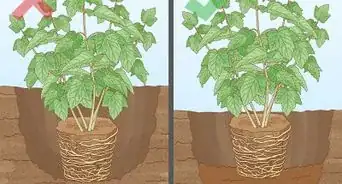



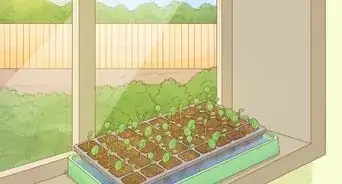

 A Complete Guide to Growing Autoflowers Outdoors (When to Plant, How Often to Water, & How Much They Yield)
A Complete Guide to Growing Autoflowers Outdoors (When to Plant, How Often to Water, & How Much They Yield)


References
- ↑ https://web.extension.illinois.edu/veggies/radish.cfm
- ↑ https://extension.umn.edu/vegetables/growing-radishes#soil-testing-and-fertilizer-447810
- ↑ https://www.fpconservatory.org/wp-content/uploads/2018/11/3-Companion-Planting-PDF.pdf
- ↑ https://ohioline.osu.edu/factsheet/hyg-1616
- ↑ https://chatham.ces.ncsu.edu/2014/10/time-to-plant-onions-and-garlic-3/
- ↑ https://extension.sdstate.edu/beets-how-grow-it
- ↑ https://s3.wp.wsu.edu/uploads/sites/2056/2018/10/Cool-Season-Planting-Chart-for-Companion.pdf
- ↑ https://web.extension.illinois.edu/veggies/lettuce.cfm
- ↑ https://www.almanac.com/companion-planting-guide-vegetables
- ↑ https://extension.umn.edu/vegetables/growing-collards-and-kale
- ↑ https://s3.wp.wsu.edu/uploads/sites/2056/2018/10/Cool-Season-Planting-Chart-for-Companion.pdf
- ↑ https://extension.psu.edu/growing-spinach-a-cool-season-vegetable
- ↑ https://www.bbc.co.uk/gardening/basics/techniques/growfruitandveg_growingcelery1.shtml
- ↑ https://www.fpconservatory.org/wp-content/uploads/2018/11/3-Companion-Planting-PDF.pdf
- ↑ https://extension.psu.edu/growing-garlic-fall-planting
- ↑ https://gardeningsolutions.ifas.ufl.edu/design/types-of-gardens/raised-beds.html
- ↑ https://ohioline.osu.edu/factsheet/HYG-1624
- ↑ https://www.fpconservatory.org/wp-content/uploads/2018/11/3-Companion-Planting-PDF.pdf
- ↑ https://ohioline.osu.edu/factsheet/hyg-1605
- ↑ https://s3.wp.wsu.edu/uploads/sites/2056/2018/10/Cool-Season-Planting-Chart-for-Companion.pdf
- ↑ https://extension.umn.edu/vegetables/growing-peppers
- ↑ https://hgic.clemson.edu/factsheet/planning-a-garden/
- ↑ https://www.hortmag.com/edible-gardening/growing-peas
- ↑ https://hgic.clemson.edu/factsheet/garden-peas/
- ↑ https://extension.uga.edu/publications/detail.html?number=C1006&title=Home%20Garden%20Green%20Beans
- ↑ https://extension.umn.edu/planting-and-growing-guides/companion-planting-home-gardens
- ↑ https://web.extension.illinois.edu/veggies/eggplant.cfm
- ↑ https://gardeningsolutions.ifas.ufl.edu/design/types-of-gardens/raised-beds.html
- ↑ https://extension.umaine.edu/publications/2067e/
- ↑ https://www.fpconservatory.org/wp-content/uploads/2018/11/3-Companion-Planting-PDF.pdf
- ↑ https://gardeningsolutions.ifas.ufl.edu/design/types-of-gardens/raised-beds.html
- ↑ https://agrilifeextension.tamu.edu/library/gardening/cucumbers/
- ↑ https://extension.umn.edu/vegetables/growing-cucumbers
- ↑ https://extension.umd.edu/resource/summer-squash-zucchini
- ↑ https://hgic.clemson.edu/factsheet/herbs/
- ↑ https://extension.umn.edu/yard-and-garden-news/ask-extension-will-perennials-grow-well-raised-beds
- ↑ https://extension.umn.edu/flowers-pollinators/annual-flowers-pollinators
About This Article

